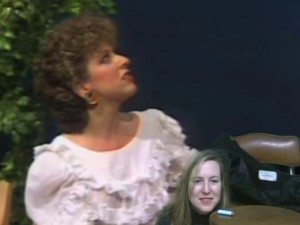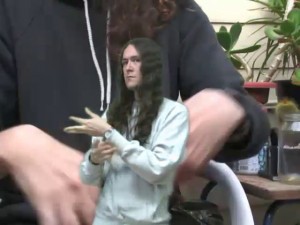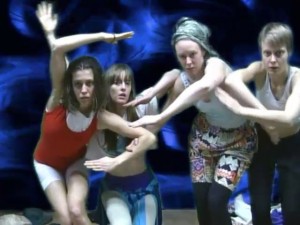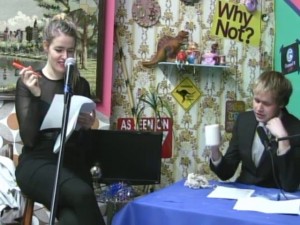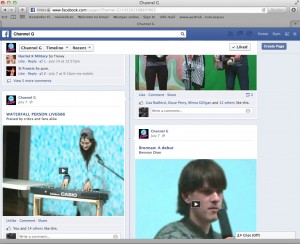‘The Internet is by its essence a machine of surveillance. It divides the flow of data into small, traceable, and reversible operations, thus exposing every user to surveillance—real or possible.’ Boris Groys
Throughout June, West Space became a live-to-air studio for Sean Peoples’s social experiment Channel G TV. Over a period of nine days performances and pre-taped mayhem were broadcast via U-Stream accompanied by schedules, nightly updates and content appearing randomly on Facebook. Peoples and his collaborators created a multidisciplinary social arts experiment exposing the strengths and weaknesses of online platforms for artistic engagement. Interestingly Channel G was based at a public gallery but viewed primarily online. In this way Peoples challenged established arts audience codes by proposing the public realm of social media as a platform for public art. His open invitation to friends, associates and relatives resulted in the production of live content that included over 100 participants.
Groys’s theories of Arts Worker and Bertolt Brecht’s theories of Epic Theatre highlight themes that are marked in Peoples’s project. Groys writes: ‘the artistic project becomes a revolutionary project that aims at the total transformation of society’. One of Peoples’s mantras ‘no EGO, no PROBLEM’ acknowledges a similar desire to revolt against polemic definitions under the gaze of public scrutiny.
I wonder does the G experience improve upon our desire to scrutinize or question; does it address the percieved non-criticality of the net while also promoting the sprawling platform for engagement?
As an act, Channel G expresses a desire for research in an area arts practitioners often leave dormant or ignore. I wonder how Peoples’s social experiment fares with Groys’s thoughts: Can egos, faults and relationships (and their intermixing) become sources for engagement and gathering?
During its nine-day life span, Channel G became a site for reality (in which there were many broadcast moments of casual socialising) and questionable privacy expressed in the plurality of practice. In gallery form, the absconded studio played its greatest hits: 60 hours of demo footage looped on screen. Facebook uploads and TV playback showed participants playing, be it in a band or in a game; chatting, on a talk show or to the director or a friend. Formal moments were juxtaposed with personal acts—searches on computer, camera set up, dress up, clean up, measuring, adjusting, feeding (a pet or themselves), drinking, kissing and dancing: functioning topics.
I asked Sean a few questions via email and over the phone.
KM: How did you approach managing the show?
SP: I really took a non-arts focus when putting it together. Most of the decisions were technical in production. My job was making people feel at ease with what they were going to do. It was apparent there were complications associated with the format months before it became a reality. The idea of participants juggling set construction, dialogue, costumes and scene changes in tandem with others was inescapable. The mantra soon became ‘How do I do my best in this impossible situation?’
Perhaps it is brave to comment ‘I took a non-arts focus’ when presenting organisation as art, but this is the new way, to gather being the statement. Which encapsulates a direction we are heading, switching towards social interdisciplinary art that is process-driven, differentiated by communicative ‘non-art’ perspectives (enabled by a renewed appreciation of a range of media sources).
I’ll admit, I got hooked on the experience of Channel G. Watching the phenomenon develop and Peoples’s craft improve was a real pleasure. I took part, then asked Sean not to republish it. As an audience member, I enjoyed observing participants in the act of posing before an unquantifiable gaze.
KM: Do you think the participants were posing?
SP: Many participants appeared to ‘pose’ to some degree—in some cases literally such as Trevelyan Clay’s work Pure Trev—but I’d like to think that any ‘posing’ was really a reflection of how everyone acts when they think no one else is around. The message was ‘Leave your ego at the door’ and ‘Do or do not. There is no try’. Letting go and not worrying about embarrassment was the mood I hoped to foster.
Theories of audience distancing itself from the actor’s identity is exemplified in Brecht’s Epic Theatre approach, or ‘Verfrumdungseffekt/Alienation Technique’. Brecht believed emotional distance should be maintained in order to ‘effectively critique and evaluate the struggle between characters and so as to understand the social realities of narrative’. Unlike Brecht, Peoples’s audience chose to interact via social media (Facebook), enabling comments, messages or phone calls from the audience to foster response from performers. Unlike Brecht’s, Peoples’s suppositions did not seek to be moral. Rather, Peoples attempted to create a celebration for us, of ourselves and comment on the power of community to embrace difference.
Brecht wanted to break the notion of disbelief employed in theatre, with the audience able to acknowledge that they were witnessing performative fiction (entertainment) and as such were able to interact, communicate and alter performances accordingly—a feature of the Channel G transmission.
Many participants responded to the 1980s-inspired, computer-generated scores that Peoples used as feature (I loved how these backing tracks were jarring experience of lo-fi late night infomercials or reminiscent of the irritation of supermarket fluorescent lighting, when hung over) and the professionally shot ad breaks. With more then 100 participants, the footage varied in length and meaning, from postcard-style snap-shots of interviews, infomercials and more familiar TV formats such as news, exercise programs and cooking demonstrations.
A critical performance with little preparation, an open journal without need for an editor, Channel G consciousness oscillated between: ‘who could be watching?’ and ‘what if people are watching?’ A few artists chose to share influences and to meta-perform: Anastasia Klose faced the camera staring passed it watching archive footage of Andy Kaufman (interviewing his ex) on screen while smoking. The green screen trick meant Klose met Kauffman with the YouTube clip screened behind her; Simon Zoric played Simon and Simon while Matthew Linde, Holly Childs and Christopher LG Hill created unsubtle text/sound performances that challenged poetics. Nathan Gray, Moontubers and Sarah CrowEST initiated live performances; Gray’s Ancient memories was an improvisational 8-piece scratch ensemble and CrowEST’s Mount activity utilised Arthur the cat searching for an object under a sheet. Masato Takasaka used computer-generated sound distortions to describe theories of the ready-made.
KM: I noticed the green scene was popular.
SP: Everyone loved the green screen! They were obsessed with watching a preview of themselves onscreen. They saw themselves in those spaces and acted as if in those spaces they weren’t present in the actual space. This caused an unconscious type of other’. I had a particular persona when people were asked to participate, come in and do their part—I was interested in what they were going to do, who with, the amount of time and what they needed. Most people wanted to explain why but I wasn’t interested in that. It didn’t matter if they were bad or awesome, if it was embarrassing that was fine. I suspected it would be in some ways, that’s why I created the wall from the front gallery to create privacy, for a sense of security. We created a few spaces, the green screen and a living room. It made the room (gallery) feel homely. Some people were really rehearsed and brought in their expectations about the camera angles and how the show would look, others would walk in and walk out and leave it up to me. The camera being there made some people feel embarrassed.
KM: How did the ideas for presentation come about?
SP: The concept of an unknown audience and the distortion of their usual practice and prepared art object as opposed to a spontaneous act was obviously challenging for some artists.
KM: What is your definition of ‘collaboration’ for the purpose of this work? Was it creating opportunities for presentation?
SP: I took a deliberate approach for the project to be seen as a collaborative effort. Channel G’s success was reflected by those participating and the programs they created. I didn’t want everybody’s hard work being solely a reflection of what I had done. I wanted to acknowledge that they had generated the work.
KM: Groys writes that ‘Jean-Paul Satre said hell is other people—life under the gaze of others’. What do you think this means in regards to Channel G?
SP: I feel like the project’s experience of ‘the eye’ was the reverse. It was supportive, the emphasis was to embrace all those mistakes.
In the spirit of Channel G here’s my moment. Also the pre-election moment, in July.
Channel G, West Space, Melbourne, 21 June – 13 July 2013.
